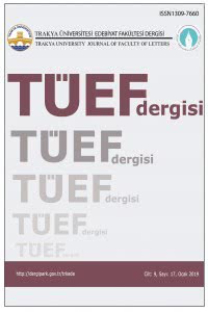THE BYRONIC HERO MYTH RELOADED IN E. L. JAMES’S FIFTY SHADES OF GREYSERIES
Byronik Kahraman Mitinin E. L. James’in Grinin Elli Tonu Eserinde Yeniden Yorumlanması
___
ALLAN, Jonathan A. (2016), “The Purity of his Maleness”, In Journal of Men’s Studies, SAGE Publications, 24.I, 24-41.BACKÈS, Jean-Louis (2010), Le Mythe dans les littératures d’Europe, Cerf éditions, coll. “Cerf Littérature”, Paris.
BLOOM, Sandra L. (2010), “Bridging the Black Hole of Trauma”, In Psychother Politics. Int., Wiley Online Library, 8.3, 198–212.
BRUNEL, Pierre, ed. (1992), Companion to Literary Myths, Heroes and Archetypes, Routledge: London.
CONCHA, Ángeles de la. (2012), “Strangers to Ourselves: Story-telling and the Quest for the Self”, Edited by Onega Susana and Ganteau Jean-Michel, In Trauma and Romance in Contemporary British Literature, Taylor&Francis Group, 127-143.
DURAND, Gilbert (1996), Introduction à la mythodologie Mythes et societes, Albin Michel, Paris.
DURAND, Gilbert (1998), Figurimiticeşichipuri ale operei, Bucureşti: Nemira.
DURAND, Gilbert (1999), The Anthropological Structures of the Imaginary. Translated by Margaret Sankey and Judith Hatten, Bumbana Publications, Brisbane.
ELAM, Diane (1992), Romancing the Postmodern, London and New York: Routledge.
GOLBAN, Petru (2013), The Foundations of English Literary Criticism: From Philip Sidney to Henry James, Lewiston: The Edwin Mellen Press, Ltd.
GOLBAN, Petru (2018), A History of Bildungsroman: From Ancient Beginnings to Romanticism, Newcastle upon Tyne: Cambridge Scholars Publishing.
GOLBAN, Tatiana (2012), “Redirecting Thematic Perspectives: Euripides’ Version of Medea Myth as the Rise of a Literary Myth”, In The Annals of Ovidius University of Constanta – the Philology Series, Constanta Romania XXIV.2, 70-78.
GOLBAN, Tatiana (2004), “Ancient and Modern Hypostases of Electra Myth”, In Dumlupinar Universitesi Sosyal Bilimler Dergisi, 11, 41-52.
GOŞA, Codruța (2014), “From Fantastic Twilight to Fifty Shades Fanfiction: Not Another Cinderella Story”, Edited by Dana Percec, In Reading the Fantastic Imagination: The Avatars of a Literary Genre, Cambridge Scholars Publisher, 57-76.
HENTSCHEL, Cedric (2016), The Byronic Teuton: Aspects of German Pessimism 1800-1933, New York: Routledge.
ILLOUZ, Eva (2014), Hard-core Romance: Fifty Shades of Grey, Best-sellers and Society, Chicago, IL: University of Chicago Press.
JAMES, E.L. (2012), Fifty Shades of Grey, London: Arrow Books.
JAMES, E.L. (2012), Fifty Shades Darker, London: Arrow Books.
JAMES, E.L. (2012), Fifty Shades Freed, London: Arrow Books.
JAMES, E.L. (2015), Grey, London: Arrow Books.
JAMES, E.L. (2017), Darker, London: Arrow Books.
KLIK, Marcin (2015), “The Crisis of the Notion of Literary Myth in French Literary Studies”, Edited by José Manuel Losada and Antonella Lipscomb, In Myth in Crisis: The Crisis of Myth., Cambridge Scholars Publishing, 91- 99.
ONEGA, Susana and GANTEAU, Jean-Michel (2012), “Traumatic Realism and Romance in Contemporary British Narrative”, Edited by Susana Onega and Jean-Michel Ganteau, In Trauma and Romance in Contemporary British Literature, Taylor&Francis Group, 1-14.
SELLIER, Philippe (1984), “Qu'est-cequ'unmythelittéraire?”, In Littérature, 55, 112-126. La farcissure. Intertextualités au XVIe siècle.
STEIN, Atara (2004), The Byronic Hero in Film, Fiction and Television, Carbondale: Southern Illinois University Press.
THORSLEV, Peter L. (1965), The Byronic Hero: Types and Prototypes, University of Minnesota Press.
TRIPODI, Francesca (2017), “Fifty Shades of Consent?”, In Feminist Media Studies, 17.1, 93-107.
VITOUX, Pierre (2007), “The Mode of Romance Revisited”, In Texas Studies in Literature and Language, 49.4, 387-410.
- ISSN: 1309-7660
- Yayın Aralığı: 2
- Başlangıç: 2011
- Yayıncı: -
Hem Vecdî Hem de Fuzûlî Divanlarında Bulunan İki Rubai Üzerine
Byronik Kahraman Mitinin E. L. James’in Grinin Elli Tonu Eserinde Yeniden Yorumlanması
Tatiana GOLBAN, Mahri BABAGULYYEVA
Tırgovişte (Eski Cuma) İli ve Yöresi Ağızlarının Söz Varlığı Üzerine Bir Değerlendirme
Orhon Yazıtlarında Özgürlük ve Başkaldırı Kavramları
THE BYRONIC HERO MYTH RELOADED IN E. L. JAMES’S FIFTY SHADES OF GREYSERIES
Tatiana GOLBAN, Mahri BABAGULYYEVA
